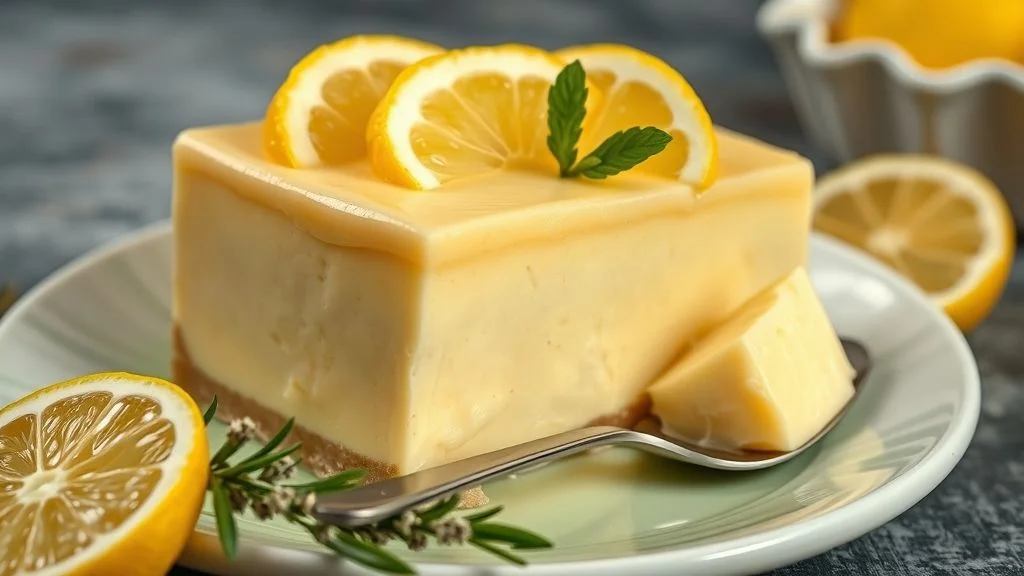Table of Contents
Introduction to Lemon Pudding
Few desserts offer the same delightful balance of sweetness and tanginess as lemon pudding. This smooth, creamy treat delivers a burst of zesty citrus flavor combined with a luscious texture, making it a favorite among dessert lovers. Whether served warm or chilled, lemon pudding is a versatile dish that pairs well with a variety of toppings, from fresh berries to crumbled cookies.
One of the key reasons for its popularity is its simplicity. Unlike more complex lemon-based desserts, such as lemon tarts or soufflés, pudding requires only a handful of basic ingredients and minimal preparation time. It is also an excellent make-ahead dessert, allowing you to prepare it in advance for dinner parties, special occasions, or a satisfying personal indulgence.
Pudding itself has a rich culinary history, evolving over centuries from traditional thickened custards to the smooth, modern versions we enjoy today. The journey of this dessert is fascinating, reflecting cultural shifts in ingredients and cooking methods. For more on how this beloved treat has developed over time, take a look at the history of pudding.
A Brief History of Lemon Pudding
Lemon pudding is deeply rooted in both British and American culinary traditions. Early versions of pudding were often made with flour or breadcrumbs as thickening agents, giving them a denser, cake-like consistency. However, over time, as techniques advanced, recipes shifted towards using cornstarch and eggs, resulting in a more delicate, custard-like texture.
The concept of pudding itself dates back centuries. In medieval England, puddings were primarily savory dishes thickened with grains, meat, or suet. Sweet variations gradually emerged, particularly in the 17th and 18th centuries, when sugar became more widely available. Lemon pudding was a natural development from these custard-based desserts, offering a refreshing citrus flavor that complemented the richness of eggs and dairy.

In America, lemon pudding cakes gained popularity in the early 20th century, a hybrid dessert that combines elements of cake and pudding in one dish. Unlike traditional puddings, which maintain a uniform texture throughout, these cakes form a spongy top layer while a creamy lemon base remains underneath.
Lemons have long been valued not just for their culinary appeal but also for their health benefits. Rich in vitamin C, they aid digestion and provide a natural boost to the immune system. To learn more about their nutritional advantages, check out this resource on the health benefits of lemons.
Classic Lemon Pudding Recipe
Making homemade lemon pudding is surprisingly easy, requiring only a few essential ingredients. This recipe ensures a silky, flavorful result every time.
Ingredients:
- ½ cup granulated sugar
- 2 tablespoons cornstarch
- Pinch of salt
- 2 cups whole milk
- 3 large egg yolks, beaten
- ⅓ cup fresh lemon juice (about 2 lemons)
- 1 tablespoon lemon zest
- 2 tablespoons unsalted butter
- 1 teaspoon vanilla extract
Instructions:
- Mix Dry Ingredients: In a medium saucepan, whisk together sugar, cornstarch, and salt.
- Add Milk: Gradually whisk in milk and place the saucepan over medium heat, stirring constantly.
- Incorporate Egg Yolks: Slowly add a small amount of hot milk mixture to the beaten egg yolks, whisking to temper them. Then, return everything to the saucepan.
- Thicken the Pudding: Continue to cook, stirring constantly, until the mixture thickens (about 5 minutes).
- Add Lemon & Butter: Remove from heat and whisk in lemon juice, lemon zest, butter, and vanilla extract.
- Chill & Serve: Pour the pudding into individual serving dishes, cover, and refrigerate for at least an hour before serving.
Pro Tips for Perfect Lemon Pudding:
✔ Use fresh lemon juice – Bottled juice lacks the vibrant flavor of fresh citrus.
✔ Avoid overcooking – High heat can cause curdling. Stir continuously.
✔ Cover with plastic wrap – Prevents a “skin” from forming on top.
Lemon Pudding Variations
Lemon pudding is incredibly versatile. With a few ingredient swaps, you can customize it to suit different dietary needs and preferences.
1. Vegan Lemon Pudding
- Replace whole milk with coconut milk or almond milk.
- Use cornstarch instead of eggs for thickening.
- Add a pinch of turmeric for color without affecting flavor.
2. Keto & Low-Carb Lemon Pudding
- Swap sugar for erythritol or monk fruit sweetener.
- Use heavy cream instead of milk for a richer texture.
- Reduce cornstarch and add gelatin for thickening.
3. Lemon Pudding Cakes
- A hybrid of lemon cake and pudding, these create a fluffy top layer with a custardy bottom.
- Uses whipped egg whites to incorporate air and achieve a light texture.
- Best baked in individual ramekins for a restaurant-quality presentation.
How to Serve Lemon Pudding

To make lemon pudding even more special, consider these serving ideas:
- Topped with whipped cream – Adds a light, airy contrast.
- Garnished with fresh berries – Strawberries, raspberries, or blueberries provide a natural sweetness.
- Paired with shortbread cookies – A crunchy contrast to the smooth pudding.
- Drizzled with honey or caramel – Enhances the flavor depth.
For formal occasions, lemon pudding can be served in elegant glassware, layered with graham cracker crumbs or meringue for added texture.
Common Lemon Pudding Mistakes & Fixes
Even with a simple recipe, some common mistakes can affect the final result.
🔸 Why is my pudding too runny?
✔ Ensure you’re using enough cornstarch or egg yolks to thicken the mixture properly.
🔸 Why does my pudding taste eggy?
✔ The egg yolks may have cooked too quickly. Always temper eggs slowly.
🔸 How do I prevent lumps?
✔ Whisk constantly and strain the pudding through a fine mesh sieve if needed.
Nutritional Information
| Nutrient | Amount per Serving |
|---|---|
| Calories | ~180 kcal |
| Carbohydrates | 28g |
| Protein | 4g |
| Fats | 6g |
| Vitamin C | 15% of RDA |
Want a healthier option? Try the vegan or keto-friendly alternatives mentioned earlier.
FAQs About Lemon Pudding
1. What is Lemon Pudding?
Lemon Pudding is a creamy, tangy dessert made with fresh lemon juice, sugar, eggs, and milk or cream. It has a smooth texture and a refreshing citrus flavor, making it a popular treat for lemon lovers.
2. Is Lemon Pudding served warm or cold?
It can be enjoyed both ways! Some people prefer it warm and silky straight from the stove, while others like it chilled for a refreshing and firm texture.
3. What gives Lemon Pudding its tangy flavor?
The fresh lemon juice and zest provide the distinct tangy taste. Using real lemons is key to achieving the bright and zesty citrus flavor.
4. Can I make Lemon Pudding without eggs?
Yes! You can substitute eggs with cornstarch or arrowroot powder for a smooth, custard-like consistency without using eggs. Some recipes also use coconut milk for a vegan alternative.
5. How long does Lemon Pudding last in the fridge?
Homemade Lemon Pudding stays fresh for 3 to 4 days when stored in an airtight container in the refrigerator.
6. Can Lemon Pudding be frozen?
Yes, but freezing may slightly change its texture. For best results, freeze it in individual portions, and thaw in the fridge before serving.
7. What can I serve with Lemon Pudding?
- Fresh berries (strawberries, raspberries, or blueberries)
- Whipped cream or meringue topping
- Crushed graham crackers or shortbread cookies
- A drizzle of honey or caramel sauce
8. How do I make Lemon Pudding thicker?
If your pudding is too thin, you can:
- Add a bit more cornstarch or flour
- Let it cook longer to allow the mixture to thicken
- Chill it in the fridge, as it naturally firms up when cooled
9. Can I use bottled lemon juice instead of fresh lemons?
Fresh lemon juice is always recommended for the best flavor, but bottled lemon juice can work in a pinch. Just ensure it’s 100% pure lemon juice without additives.
10. What’s the difference between Lemon Pudding and Lemon Curd?
While both have a rich, lemony flavor, they differ in texture:
- Lemon Pudding is lighter and creamier, often made with milk or cream.
- Lemon Curd is thicker and richer, with more eggs and butter, making it a spread rather than a dessert on its own.
Final Thoughts

A smooth, tangy, and refreshing dessert, Lemon Pudding is the perfect way to satisfy your citrus cravings. Whether you prefer it warm and comforting or chilled and creamy, this classic treat is a must-try for lemon lovers. Its bright flavor and velvety texture make it an excellent choice for any occasion.
If you’re a fan of lemon-infused desserts, you’ll also love this Lemon Zest Cake Recipe, a perfect balance of sweet and tangy flavors. For an easy, no-bake alternative, try this No-Bake Lemon Éclair Cake, a decadent, creamy delight that requires minimal effort. And if you enjoy experimenting with citrus flavors, don’t miss this Orange Almond Cake, a moist and nutty twist on classic citrus cakes.
So, grab a spoon and enjoy a luscious bowl of homemade Lemon Pudding—a dessert that’s as refreshing as it is indulgent!

